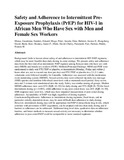Safety and Adherence to Intermittent Pre-Exposure Prophylaxis (PrEP) for HIV-1 in African Men Who Have Sex with Men and Female Sex Workers

View/
Date
4/12/2012Author
Mutua, Gaudensia
Sanders, Eduard
Mugo, Peter
Anzala, Omu
Haberer, Jessica E.
Bangsberg, David
Barin, Burc
Rooney, James F.
Mark, David
Chetty, Paramesh
Fast, Patricia
Priddy, Frances H
Type
ArticleLanguage
enMetadata
Show full item recordAbstract
Background: Little is known about safety of and adherence to intermittent HIV PrEP regimens, which may be more feasible
than daily dosing in some settings. We present safety and adherence data from the first trial of an intermittent PrEP regimen
among Kenyan men who have sex with men (MSM) and female sex workers (FSW).
Methods/Principal Findings: MSM and FSW were randomized to daily oral FTC/TDF or placebo, or intermittent (Monday,
Friday and within 2 hours after sex, not to exceed one dose per day) oral FTC/TDF or placebo in a 2:1:2:1 ratio; volunteers
were followed monthly for 4 months. Adherence was assessed with the medication event monitoring system (MEMS).
Sexual activity data were collected via daily text message (SMS) queries and timeline followback interviews with a onemonth
recall period. Sixty-seven men and 5 women were randomized into the study. Safety was similar among all groups.
Median MEMS adherence rates were 83% [IQR: 63–92] for daily dosing and 55% [IQR:28–78] for fixed intermittent dosing
(p = 0.003), while adherence to any post-coital doses was 26% [IQR:14–50]. SMS response rates were low, which may have
impaired measurement of post-coital dosing adherence. Acceptability of PrEP was high, regardless of dosing regimen.
Conclusions/Significance: Adherence to intermittent dosing regimens, fixed doses, and in particular coitally-dependent
doses, may be more difficult than adherence to daily dosing. However, intermittent dosing may still be appropriate for PrEP
if intracellular drug levels, which correlate with prevention of HIV acquisition, can be attained with less than daily dosing
and if barriers to adherence can be addressed. Additional drug level data, qualitative data on adherence barriers, and better
methods to measure sexual activity are necessary to determine whether adherence to post-coital PrEP could be comparable
to more standard regimens.
Citation
PLoS ONE 7(4): e33103.Collections
- Faculty of Health Sciences (FHS) [10378]
